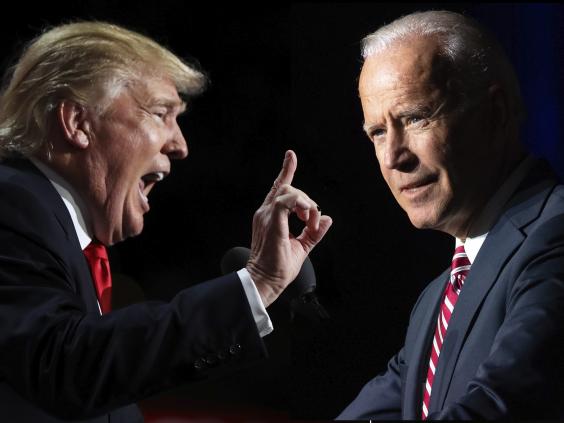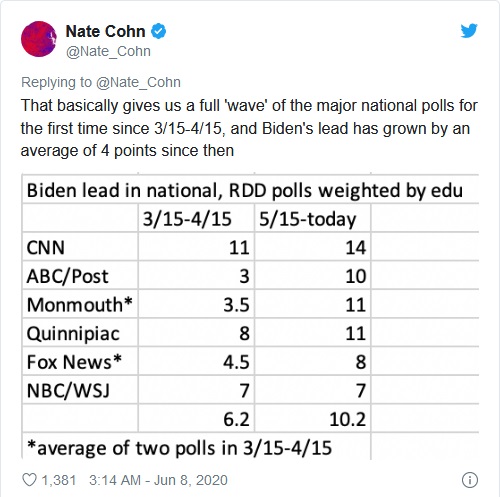A new CNN poll out today shows Joe Biden with a staggering 14-point lead over President Trump as the electorate’s stated level of concern with “race relations” soars and the former vice president is seen as much better equipped to handle the issue.
A new Garin-Hart-Yang Research poll, also out today, finds Biden leading Trump, 53 percent to 41 percent, with 56 percent saying it’s ‘time for a change and someone new.’
That same poll found only 38 percent of voters believe Trump deserves another four years as president.
A recent Fox News poll showed Biden leading Trump in Ohio, a state the president won by 8 points in 2016.
No GOP scenario gets Trump to 270 electoral votes if he loses the Buckeye State.
There is now a very clear trend in national polling — Biden was winning before the outbreak of massive national protests in the wake of George Floyd’s death, and that lead has gotten bigger.
Trump is sour about it, tweeting today that CNN’s poll is “fake news” while later tweeting that he has a 96 percent approval rating in the Republican Party.
There is literally no evidence that this is the case and no reason to think either that Trump’s approval rating would be so static or that so many Republicans would approve of his presidency so steadfastly.
Ninety-six percent approval is the territory of the autocrats Trump so often tries to emulate, but those figures are themselves obviously fake.
Trump repeats claims like these over and over because he knows that they occasionally stick, even among skeptical observers.
His claims about his popularity are regurgitated by his supporters; anyone you see repeating them uncritically should be immediately be treated as nonserious.
His assertions about the validity of polls like CNN’s, though, are a bit different, leveraging skepticism of polling in general — and the results in 2016 — as a way to raise questions about the poll results and, therefore, how his candidacy is faring.
What’s happening, in fact, is that Trump is losing, that he has been unable to expand his support and is relying on his 2016 strategy of being the best-liked disliked candidate in order to win.
The RealClearPolitics polling average shows that this isn’t working and that Biden’s margin of support over Trump remains both constant and a function of his own relative popularity compared to the incumbent president.
As Nate Cohn, the New York Times’s polling and data guru, explains, every single high-quality national poll with proper education weighting had Biden leading two months ago. And almost all of them have him leading by more today.
For reference, Biden’s lead in the polls is larger than Hillary Clinton’s was in early June. He’s up by about 8 points in the current RealClearPolitics average while Clinton’s lead was closer to 5 points.
Clinton did break out to about a 7-point lead in mid-October after widespread discussion of a recording in which Trump can be heard talking about sexually assaulting women.
But Biden’s lead is not only larger than that, it’s more secure.
Even on October 18, Clinton was only at 46 percent in the polls with Trump doing terribly at 39 and plenty of undecided and third-party voters.
Today’s average, by contrast, has Biden at 50 percent with Trump at 42.
That much smaller number of undecided or third-party voters augurs a more stable race and a more difficult road for Trump to a come-from-behind victory.
Of course, people who remember confident forecasts of a Clinton win may have their doubts.
But it’s important to recall that this was more a case of bad forecasting than of bad polling.
In the 2016 cycle, the non-FiveThirty Eight forecasters generally modeled each state separately.
That meant that if Clinton had a narrow polling lead in Pennsylvania, and a narrow lead in Wisconsin, and a narrow lead in Michigan, and a narrow lead in Florida, and a narrow lead in North Carolina, the models treated it as reasonably likely that she might in fact lose one of those states but incredibly unlikely that she would lose all five.
A coin toss is 50-50, but the odds of losing five coin tosses in a row are about 3 percent.
Many models treated Clinton’s odds in each swing state as somewhat better than a coin toss, thus creating the result that it was extraordinarily unlikely that she would lose all five.
A different way to think about it is that if polls in Michigan are wrong because they undercounted the number of non-college white Trump voters, this should be a factor in every state with large numbers of non-college whites.
That’s almost every state in the union, and certainly every swing state.
When you understand polling error that way, then Clinton’s real but narrow lead in the polls should have been understood as making it unlikely that she would lose but only moderately so.
This Biden lead is different. If you’re up 10 points in the polls, then the polls could be off by 4 points (which would be a big but not mind-blowing error) and the Electoral College could have a 4-point skew toward Trump (which is at the upper range of plausibility but not totally out there) and Biden would still win.
Basically, if you are up 10 in the polls, you are almost certainly going to win.
None of this means that Biden will win in November, simply because a lot of things will happen between now and then.
But we have very good reason to believe that if the election happened tomorrow, Biden would win — for it to be otherwise would involve a massive breakdown in polling, not a “normal” kind of statistical error.

